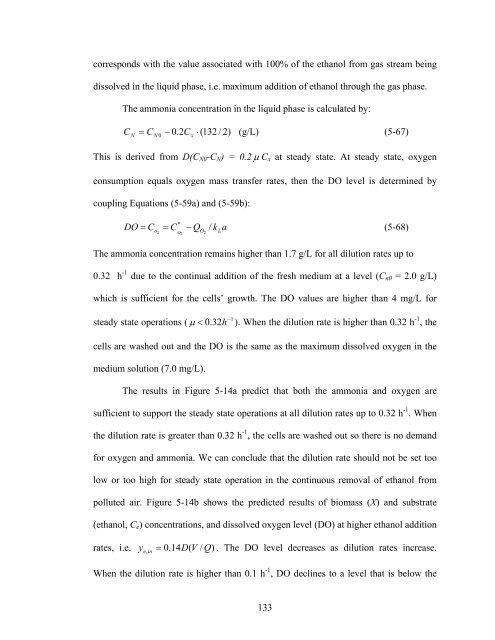Experimental Study of Biodegradation of Ethanol and Toluene Vapors
Experimental Study of Biodegradation of Ethanol and Toluene Vapors
Experimental Study of Biodegradation of Ethanol and Toluene Vapors
Create successful ePaper yourself
Turn your PDF publications into a flip-book with our unique Google optimized e-Paper software.
corresponds with the value associated with 100% <strong>of</strong> the ethanol from gas stream being<br />
dissolved in the liquid phase, i.e. maximum addition <strong>of</strong> ethanol through the gas phase.<br />
The ammonia concentration in the liquid phase is calculated by:<br />
C C − 0.2C<br />
(132 / 2) (g/L) (5-67)<br />
N<br />
=<br />
N 0 x<br />
⋅<br />
This is derived from D(C N0 -C N ) = 0.2 μ C x at steady state. At steady state, oxygen<br />
consumption equals oxygen mass transfer rates, then the DO level is determined by<br />
coupling Equations (5-59a) <strong>and</strong> (5-59b):<br />
*<br />
DO = C = C − Q k a<br />
(5-68)<br />
o O O<br />
/<br />
2<br />
2<br />
2<br />
L<br />
The ammonia concentration remains higher than 1.7 g/L for all dilution rates up to<br />
0.32 h -1 due to the continual addition <strong>of</strong> the fresh medium at a level (C n0 = 2.0 g/L)<br />
which is sufficient for the cells’ growth. The DO values are higher than 4 mg/L for<br />
steady state operations ( μ < 0.32h<br />
−1<br />
). When the dilution rate is higher than 0.32 h<br />
-1 , the<br />
cells are washed out <strong>and</strong> the DO is the same as the maximum dissolved oxygen in the<br />
medium solution (7.0 mg/L).<br />
The results in Figure 5-14a predict that both the ammonia <strong>and</strong> oxygen are<br />
sufficient to support the steady state operations at all dilution rates up to 0.32 h -1 . When<br />
the dilution rate is greater than 0.32 h -1 , the cells are washed out so there is no dem<strong>and</strong><br />
for oxygen <strong>and</strong> ammonia. We can conclude that the dilution rate should not be set too<br />
low or too high for steady state operation in the continuous removal <strong>of</strong> ethanol from<br />
polluted air. Figure 5-14b shows the predicted results <strong>of</strong> biomass (X) <strong>and</strong> substrate<br />
(ethanol, C e ) concentrations, <strong>and</strong> dissolved oxygen level (DO) at higher ethanol addition<br />
rates, i.e.<br />
y e in<br />
=<br />
,<br />
0.14D(<br />
V / Q)<br />
. The DO level decreases as dilution rates increase.<br />
When the dilution rate is higher than 0.1 h<br />
-1 , DO declines to a level that is below the<br />
133















